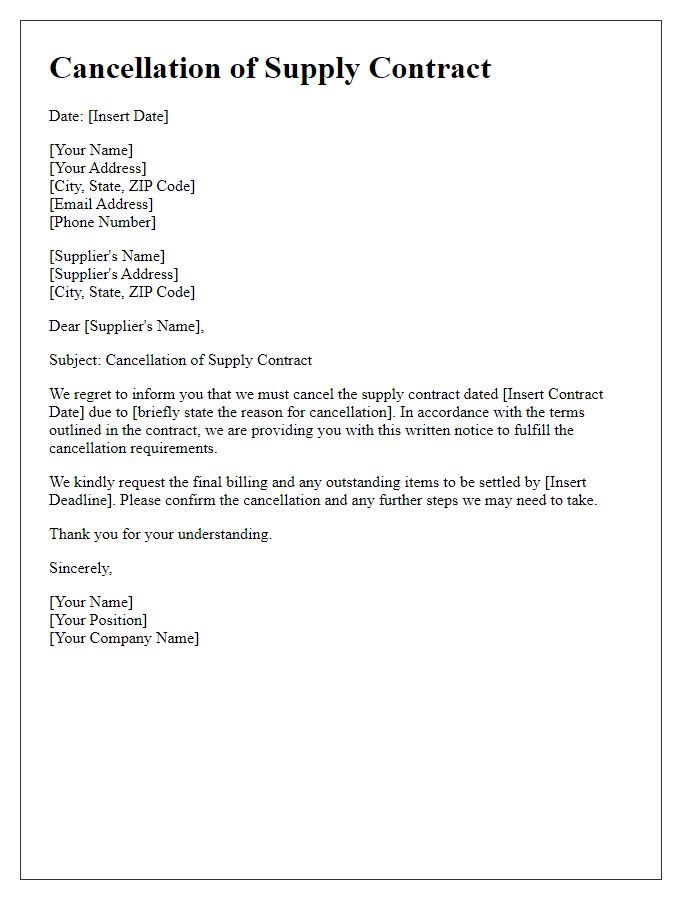When it comes to ending a supply contract, clear communication is essential to ensure a smooth transition for both parties. A well-crafted termination letter outlines the necessary details and reinforces professional relationships, even in challenging situations. It's important to express appreciation for the past collaboration while also setting out the terms of the termination. If you're looking for a structured approach to drafting your own termination letter, read on for a comprehensive template and helpful tips!

Clear Subject Line
Termination of Supply Contract Notification The termination of a supply contract impacts both parties significantly. A clear subject line such as "Termination of Supply Contract Notice - [Contract Number/Title]" allows for immediate recognition of the message's intent. This document should specify the contract details, including the effective termination date, which may be in line with contract stipulations, usually requiring advance notice (30 days is common). Include reasons for termination, such as failure to meet delivery timelines, quality standards, or changes in business strategy. Providing a formal closure also involves mention of any outstanding obligations, like final payments or return of materials. It is essential to maintain professionalism throughout and outline any necessary steps for the transition process for both parties.
Effective Date of Termination
Effective termination of a supply contract occurs when either party sends written notice to the other party, ensuring compliance with specified terms. The termination date must be clearly stated, typically requiring a minimum notice period, often outlined in the contract terms, such as 30 days. This notice alerts both parties to significant changes in their business relationship, particularly affecting inventory management and resource allocation. It is crucial for all involved parties to note the final obligations regarding outstanding payments and the return of any remaining goods or confidential information. In legally binding contracts, the effective date serves as a key milestone for transitions, clarifying the cessation of services and ensuring a smooth winding down of responsibilities.
Reason for Termination
Termination of a supply contract can arise from various factors, such as persistent delays in delivery, failure to meet quality standards, or significant changes in market conditions. For instance, if a supplier consistently fails to deliver products, like raw materials for manufacturing, within agreed timelines, it can disrupt production schedules and lead to financial losses. Additionally, if delivered goods, such as components or equipment, do not meet specified quality standards, it can compromise the integrity of the end products, resulting in customer dissatisfaction and potential legal liabilities. Market shifts, like sharp increases in tariffs or supply chain disruptions due to unforeseen events, can also render previous agreements untenable, prompting businesses to seek alternative suppliers to mitigate operational risks and sustain profitability.
Obligations and Liabilities Post-Termination
Termination of supply contracts often leads to obligations and liabilities that must be carefully managed. After ending agreements, such as those specified between two parties involved in a business arrangement, obligations may include the return of unsold goods, settlement of any outstanding payments, and adherence to confidentiality clauses regarding proprietary information. Specific liabilities may arise from potential breaches of contract or failure to fulfill agreed-upon terms, which could involve legal repercussions in jurisdictions such as the United States or the European Union. Companies must ensure compliance with regulatory timelines for notifications or settlements to mitigate risks. Proper documentation of all transactions and correspondence is essential to address any disputes that may arise following termination.
Contact Information for Further Clarification
The termination of a supply contract requires clarity and precision. Key details include the names and roles of parties involved, such as suppliers and buyers, along with contract reference numbers to ensure proper identification. The date of termination must be specified, often allowing for a notice period, which is typically 30 days based on standard practices. Locations of contract execution and any relevant compliance regulations must also be noted to clarify jurisdiction. For further clarification, designated contact persons should be listed, including names, job titles, email addresses, and direct phone lines to facilitate effective communication.













Comments